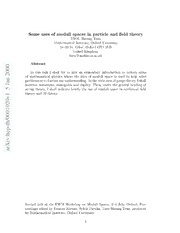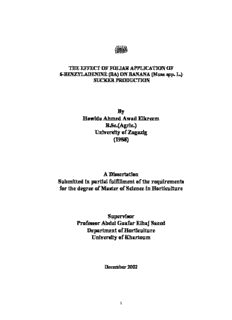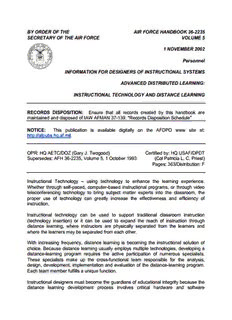
Some uses of moduli spaces in particle and field theory PDF
Preview Some uses of moduli spaces in particle and field theory
Some uses of moduli spaces in particle and field theory TSOU Sheung Tsun Mathematical Institute, Oxford University 24–29 St. Giles’, Oxford OX1 3LB United Kingdom. tsou@maths.ox.ac.uk Abstract 0 0 0 In this talk I shall try to give an elementary introduction to certain areas 2 of mathematical physics where the idea of moduli space is used to help solve n problemsortofurtherourunderstanding. Inthewideareaofgaugetheory, Ishall a J mention instantons, monopoles and duality. Then, under the general heading of 5 string theory, I shall indicate briefly the use of moduli space in conformal field 1 theory and M-theory. v 0 2 0 1 0 0 0 / h t - p e h : v i X r a Invited talk at the EWM Workshop on Moduli Spaces, 2–3 July, Oxford; Pro- ceedings edited by Frances Kirwan, Sylvie Paycha, Tsou Sheung Tsun, produced by Mathematical Institute, Oxford University. 1 1 Introduction Physicists seldom define their terms. So although I know roughly what a moduli space is, and the sort of thing one does with it in physics, I was not really very sure of what exactly it is. So I asked Frances (Kirwan), just as the Balliol College (whereparticipantswerelodged)portersdidwhentheyalsowanted toknowwhat a moduli space was. I have always taken it to be some sort of useful parameter space, convenient inthesensethatmathematicianshavealreadyworkedoutallits properties (at least in the classical cases). But Frances told me something much more significant—she describes it as a parameter space in the nicest possible way. So in the next 55 minutes or so, I shall try to give you a rough picture of how physicists have made use of this nice concept of a parameter space. We should note, however, that it is far from a one-way traffic. Much of the tremendous progress in 4-manifold theory, and a large part of it is done here, came about by studying certain moduli spaces occurring in mathematical physics. A few notes of warning, however, are in place. For a hard-nosed or pragmatic physicist, (A) spacetime X has 4 dimensions, 3 space and 1 time, with an indef- inite metric. By an indefinite metric I mean that the quadratic form giving the metric is not positive definite, so that two distinct points in spacetime can be null-separated. In fact, distances along light-paths are always zero. For him (or her) also (B) spacetime is by and large like R4, that is, (i) flat, (ii) looking more or less the same in all directions, (iii) real, and (iv) more or less infinite in all its 4 directions and hence non-compact. On the other hand, algebraic geometry is more about Riemannian manifolds and the best results are almost always obtained for the compact case. In order to make contact, the concept of spacetime has to be modified in several significant ways. 1. One considers definite metrics, a process known as euclideanization. Then many nice things happen. In particular, the wave operator ∂2 ∂2 ∂2 ∂2 2 = − − − ∂t2 ∂x2 ∂y2 ∂z2 which is hyperbolic, becomes the 4-dimensional Laplacian ∂2 ∂2 ∂2 ∂2 ∇2 = + + + ∂t2 ∂x2 ∂y2 ∂z2 which is elliptic, and for elliptic operators there are all sorts of good results like the index theorems. Euclideanization is done inthe following: Self-dual Yang–Mills theory, instantons, monopoles, Seiberg–Witten theory, strings, .... 2. Alternatively, one complexifies spacetime, and then the question of definite or indefinite metric disappears. In this case, one can use powerful complex 2 manifold techniques including twistor theory. This is also where supersym- metry comes in mathematically. Moreoever, by a change of point of view (see later), Riemann surfaces also play an important role. Complexification is done in superstrings, supersymmetric Yang–Mills theory, M-theory, .... 3. One also changes the topology of spacetime by compactifying some or all of its directions. In some cases, this is only a mild change, amounting to imposing certain decay properties at infinity (see later). In other cases, this gives rise to important symmetries of the theory. Compactification is done in instantons, superstrings, M-theory, .... 4. One either changes the number of spacetime dimensions or re-interprets some of them as other degrees of freedom. This dimensional change is done in strings, superstrings, monopoles, M-theory, .... Atfirst sight, thesemodificationslookdrastic. Thehopeisthattheysomehow reflect important properties of the real physical world, and that the nice results we have do not disappear on us once we know how to undo the modifications. Surprisingly, the (largely unknown) mathematics underlying real 4-dimensional spacetime looks at present quite intractable! 2 Yang–Mills theory (Gauge theory) Unlike most of the other theories I shall mention, Yang–Mills theory is an exper- imentally ‘proven’ theory. In fact, it is generally believed, even by hard-nosed or pragmatic physicists, that Yang–Mills theory is the basis of all of particle physics. From the physics point of view, Yang–Mills theory is the correct frame- work to encode the invariance of particle theory under the action of a symmetry group—the gauge group G—at each spacetime point. For example, let ψ(x) be the wave-function of a quantum particle. Then the physical system is invariant under the action of the group: ψ(x) 7→ Λ(x)ψ(x), Λ(x) ∈ G. This invariance is known as gauge invariance. Now the groups that are most relevant to particle physics are U(1),SU(2),SU(3). However, we shall come across other groups as well. But for simplicity, we shall take G = SU(2), unless otherwise stated. There is an additional ingredient in many favoured gauge theories, namely supersymmetry. This is a symmetry relating two kinds of particles: bosons (e.g. a photon) with integral spin and fermions (e.g. an electron) with half-integral spin. Spin is a kind of internal angular momentum which is inherently quantum mechanical. Since bosons and fermions in general behave quite differently (e.g. they obey different statistics), this symmetry is not observed in nature. However, 3 one can imagine this symmetry holding for example at ultra-high energies. What makes this symmetry theoretically interesting is that many theories simplify and oftenbecomecomplex analyticwiththis extra symmetry, making much oftheun- derlying mathematics accessible. Also the complex analyticity links such theories with most studies of moduli spaces. Mathematically, Yang–Mills theory can be modelled (in the simplest case) by a principal bundle P (see Figure 1) together with a connection on it. I remind P F G π X Figure 1: Sketch of a principal bundle you that, roughly speaking, a principal bundle is a manifold P with a projection π onto a base space X, and a right action by the structure group G. In general, the base space can be any smooth manifold, but here we consider only the case of spacetime X. Above each pointx ∈ X, the inverse image (called the fibre)π−1(x) is homeomorphic to G. The total space P is locally a product, in the sense that X is covered by open set U and π−1(U ) is homeomorphic to U ×G. A connection α α α A is a 1-form on P with values in the Lie algebra g of G, satisfying certain conditions and giving a prescription for differentiating vectors and tensors on X. It combines with the usual exterior derivative d to give the covariant exterior derivative d : A d = d+A A in such a way as to preserve gauge invariance. Next we need the curvature 2-form: F = dA+AA (F = ∂ A −∂ A +ig[A ,A ]). A µν ν µ µ ν µ ν The second formula (in brackets) is the same as the first one, but written in local coordinates, or ‘with indices’, where µ = 0,1,2,3. 4 Since dimX = 4 (for the moment, anyway), we have the Hodge star operator which takes 2-forms to 2-forms: ∗: Ω2 → Ω2 ∗ F 7→ F . A A In local coordinates, this can be written as 1 ∗F = − ǫ Fρσ, µν µνρσ 2 where ǫ is a completely skew symbol defined by ǫ = 1. Notice that µνρσ 0123 (∗)2 = +1 in euclidean metric (∗)2 = −1 in Minkowskian metric. Yang–Mills theory is given by the Yang–Mills action or functional 1 1 S(A) = tr(F ∗F ) = kF k2. A A A 8π2 Z 8π2 X The curvature satisfies: d F = 0 (Bianchi identity) A A ∗ d F = 0 (Yang−Mills equation). A A These are the classical equations for Yang–Mills theory. Notice that the first one is an identity from differential geometry, and the second one comes from the first variation of the action. The space of connections A is an affine space, but we are really interested in connections modulo gauge equivalence. Two connections A,A′ are gauge equiv- alent if they are ‘gauge transforms’ of each other: A′ = Λ−1AΛ+Λ−1dΛ. In other words, Λ(x) ∈ G, Λ is a fibre-preserving automorphism of P invari- ant under the action of G. We shall use the symbol G for the group of gauge transformations Λ. So we come to our first, most basic, moduli space M¯ = A/G. It is in general infinite-dimensional with complicated topology. We shall be interested in various subspaces or refinements of M¯. 5 One theoretical use of M¯ itself is in (the euclidean formulation of) quantum field theory, where with the Feynman path integral approach, one has to consider ¯ the integral of the exponential of the Yang–Mills action over M: e−S(A). ZM¯ But this integral is very difficult to define in general! The moduli space M¯ has a singular set which represents the reducible con- nections, which are connections with holonomy group H ⊂ G such that the centralizer of H properly contains the centre of G. We say then that the con- nection reduces to H. The complement M of this singular set is dense in M¯, and represents the irreducible connections. For G = SU(2), near an irreducible connection M¯ is smooth, but reducible connections lead to cone-like singularities ¯ in M. 2.1 Instantons Recall that G = SU(2). Bundles P over X are classified by the second Chern class of the associated rank 2 vector bundle E (cf. Rosa-Maria Mir´o-Roig’s talk): 1 k = c (E)[X] = trF2 ∈ Z. 2 8π2 Z A X We say that a connection A is self-dual (or anti-self-dual) if its curvature F A satisfies ∗ ∗ F = F (resp. F = −F ). A A A A Then given any connection A, we can decompose the corresponding curvature F A into its self-dual and and anti-self-dual parts: F = F+ +F−. A A A In the context of Yang–Mills theory a self-dual connection is called an instan- ton1: ∗ − F = F ⇔ F = 0. A A A In this case, ∼ Bianchi identity = Yang−Mills equation. In other words, a self-dual connection is automatically a classical solution. Now we have 1 S(A) = |F+|2 +|F−|2 8π2 Z A A X 1 k = |F+|2 −|F−|2. 8π2 Z A A X 1It is a matter of conventionwhether one so defines a self-dual or anti-self-dualconnection. 6 Hence one has immediately S(A) ≥ k, and − S(A) = k ⇔ F = 0. A So a self-dual connection gives an absolute minimum for the action. The integer k is known as the instanton number. Warning: Nontrivial self-dual connections exist only when X is either eu- clidean or complex. The mathematical magic of instantons is that instead of solving the second order Yang–Mills equations we have only the first order self-duality equation to deal with. These connections can actually be constructed using euclidean twistor methods without explicitly solving any equations (cf. Tatiana Ivanova’s talk). Physically, the presence of instanton contribution in the path integral allows tunnellingbetweendifferent vacua(i.e.lowest energystates)oftherelevantYang– Mills theory (namely quantum chromodynamics for strong interactions or QCD). This role of the instantons can be compared to lower-dimensional objects such as ‘solitons’ortopologicaldefectscalled‘kinks’whichconnectuptwodifferentstates at infinity (see Figure 2). The two phenomena are quite similar, since ‘tunnelling’ means a quantum particle can penetrate a potential barrier which a classical particle cannot go through, thus connecting two classically separate states. The Figure 2: Sketch of a kink connecting two different states effect of instantons is ‘non-perturbative’ in the sense that such an effect cannot be obtained as a term in a power series expansion of g the coupling constant (which is measure of the ‘strength’ of the interaction under consideration, and 7 which appears for example in the nonlinear term of the curvature formF ). This µν is a direct manifestation of the fact that instantons are topological in nature and cannot be obtained by any ‘local’ considerations such as power series expansions. Since in euclidean space the Yang–Millsequations areelliptic, andconcentrat- ing on irreducible connections gets rid of zero eigenvalues, one can use the index theorem to count the ‘formal dimension’ of instanton moduli space. Typically the smooth part of the moduli space will have this formal dimension as its actual dimension. For example, X = S4, dimC(MI,k) = 8k −3. Uhlenbeck has given a unique compactification of M , the union for all k. For I moredetailsaboutinstantonmodulispaces, IagainreferyoutoTatianaIvanova’s talk. 2.2 Monopoles Recall G = SU(2). ConsideraYang–Millstheorywithascalarfield(calledHiggs field)φ,together with a potential term V(φ) which is added to the Yang–Mills action. Suppose further that V(φ ) = minimum for |φ | =6 0, 0 0 and that V(φ) is invariant under a subgroup U(1) ⊂ SU(2). Then for those connections of P which are reducible to this U(1) subgroup, we can for certain purposes concentrate on this ‘residual gauge symmetry’ and have a U(1) gauge theory. If we interpret this U(1) as Maxwell’s theory of electromagnetism, then a non-trivialreduction ofP canberegardedasamagnetic monopole. Themagnetic charge k is given by the first Chern class of the reduced bundle. In fact we have the following exact sequence which gives us an isomorphism: ∼ π (SU(2)) → π (SU(2)/U(1)) → π (U(1)) → π (SU(2)) 2 2 1 1 k k 0 0 Unlike the original magnetic monopole considered by Dirac, these ’t Hooft– Polyakov monopoles have finite energy and are the soliton solutions of the field equations corresponding to the action: S(A,φ) = S(A)+kDφk2+λ(1−|φ|2)2, where the last term is the usual form of the potential V(φ). From this we get the Yang–Mills–Higgs equations (YMH): D F = 0, A ∗ D F = −[φ,D φ], A A D ∗D φ = 2λφ(|φ|2−1). A A 8 Now we specialize to a certain limit, the Prasad-Somerfeld limit: V(φ) = 0, but |φ| → 1 at infinity. Then the Yang–Mills–Higgs system becomes: D F = 0, A ∗ D F = −[φ,D φ], A A ∗ D D φ = 0. A A ConsidernextaYang–MillstheoryineuclideanR4,invariantunderx -translations. 4 Then we can write A = A dx +A dx +A dx +φdx , 1 1 2 2 3 3 4 where A ,A ,A ,φ are Lie algebra-valued functions on R3. The action can be 1 2 3 written as S(A) = kF k2 = kFk2 +kDφk2, A where now F is the curvature of the connections in 3 dimensions: ′ A = A dx +A dx +A dx , 1 1 2 2 3 3 and D is the corresponding 3-dimensional covariant derivative. In this way, we can make the following identification since the actions for the two theories are identical: YMH on R3 ∼= dimensionally reduced YM on R4. In this case, ∗ F = F ⇒ first 2 YMH. A A Hence a solution to the Bogomolny equation ∗ F = D φ A gives a solution of YMH. These are known as ‘static monopoles’. The moduli spaces M corresponding to a given charge k are well studied, at k least for k = 1,2. The translation group R3 acts freely on M , so does an overall k phase factor S1. Dividing these out we get the reduced monopole moduli spaces M0k, dimC = 4k −4. Taking the k-fold covers, one obtains: M˜ ∼= R3 ×S1 ×M˜0. k k Thespecialcaseofk = 2hasbeenstudiedbyAtiyahandHitchinasanentirely novel way of obtaining the scattering properties of two monopoles, using a metric on M0 they discovered, and assuming (with Manton) that geodesic motion on 2 it describes adiabatic motion of the two monopoles. This is the most direct use that I know of of moduli space for deriving something akin to dynamics! 9 2.3 Topological field theory I wish just to mention a class of quantum field theories called topological quantum field theories (TQFT), where the observables (correlation functions) depend only on the global features of the space on which these theories are defined, and are independent of the metric (which, however, may appear in the classical theory). Atiyah gave an axiomatic approach to these, but there are so many local experts here that I do not feel justified in expanding on that! Instead, I shall just indicate the role of moduli space in Witten’s approach. Starting with a moduli space M one can get fields, equations and symmetries of the theory. Witten postulates the existence of certain operatorsO corresponding i to cohomology classes η of M such that i hO ···O i = η ···η , 1 n 1 n Z M where h···i denotes the correlation function of the operators. Hence he obtains thesecorrelationfunctionsasintersectionnumbersofM,usingDonaldsontheory. So in a sense the TQFT is entirely defined by M. The observables called correlation functions can best be understood in the case of, for example, a 2-point function in statistical mechanics. This is the probability, given particle 1, of finding particle 2 at another fixed location. TogointoanyfurtherdetailsaboutTQFTwouldrequiremoredetailedknowl- edge both of quantum field theory and supersymmetry. These would lead us unfortunately too far from the context of this workshop. 2.4 Seiberg–Witten theory Recall that a spin structure on X is a lift of the structure group of the tangent ∼ bundle of X from SO(4) to its double cover Spin(4)= SU(2)×SU(2). Because of this isomorphism, one can represent a spin structure more concretely as a pair of complex 2-plane bundles S+,S− → X, each with structure group SU(2). A slightly more general concept is a spinc structure over X, which is given by a pair of vector bundles W+,W− over X with an isomorphism for the second exterior powers Λ2W+ = Λ2W− = L, say, such that one has locally W± = S1 ⊗L12, 1 1 1 where L2 is a local square root of L:L2 ⊗L2 = L. Given a spinc manifold X, the Seiberg–Witten equations (SW) are written for a system consisting of 1) a unitary connection A on L = Λ2W±, and 2) ψ a section of W+. Then these equations are: D ψ = 0 A F+ = −τ(ψ,ψ), A 10
The list of books you might like

Corrupt (Devil's Night #1)

Shatter Me Complete Collection (Shatter Me; Destroy Me; Unravel Me; Fracture Me; Ignite Me)

The Sweetest Oblivion (Made Book 1)

Do Epic Shit

Bugles and a Tiger

Capitolul 4.1 Apa

Greek Government Gazette: Part 7, 2006 no. 892

BY ORDER OF THE SECRETARY OF THE AIR FORCE AIR FORCE INSTRUCTION 11-2E-3 ...

The Haunting Of Whaley House

By Howida Ahmed Awad Elkreem B.Sc.(Agric.)

Systematics of Global Observables in Cu+Cu and Au+Au Collisions at RHIC Energies

Kirkus Reviews 1993: Vol 62 Index

Symmetry Energy in the Equation of State of Asymmetric Nuclear Matte

Technology, information and the decentralization of the firm

Energies of Quantum QED Flux Tubes

The Thames by Mortimer Menpes

BY ORDER OF THE AIR FORCE HANDBOOK - The Air University

Openings in the Old Trail by Bret Harte

Il Tender n. 43

THIS ISN'T BUSINESS, IT'S PERSONAL: PERSONAL NARRATIVES IN THE FIELD OF ...




